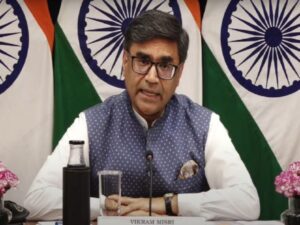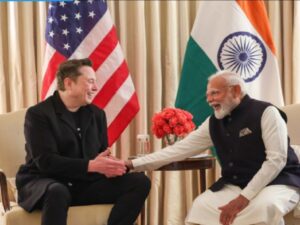Ukraine war: US and allies may supply longer-range missiles how this would change the conflict
Bradford (UK), Sep 15 (The Conversation) Noises from Washington indicate that US president Joe Biden may be about to overcome his reluctance to supply Ukraine with the longer-range missiles it desperately needs.
According to a report from CNN on September 11, which quoted “an official familiar with the discussions”, a final decision about the supply of army tactical missile systems (ATACMS) to Ukraine had not yet been made. But, according to CNN’s source, there is “a much greater possibility of it happening now than before Much greater. I just don’t know when.”
The slow progress of Ukraine’s spring and summer counteroffensive has underscored the need for additional weapons capabilities. In particular, Ukraine is asking for missiles that can strike in Russia’s “deep rear” allowing Kyiv to target Russian field headquarters and supply depots.
In an article for Lichtenstein-based thinktank, Geopolitical Intelligence Services (GIS) published in August, the secretary of the Ukraine’s National Security and Defence Council, Oleksiy Danilov, set out a shopping list of weapons systems. This included ammunition and artillery shells of varying calibre, longer-range missile systems, cruise missiles, multifunctional aircraft and helicopters and drones (Danilov said Russia had a five-to-one advantage in drones).
Kyiv is also seeking sophisticated robotic de-mining equipment and is encouraging its allies to set up maintenance and repair facilities for western weapons in countries bordering Ukraine.
During the summer of 2022, the US supplied guided multiple launch rocket systems, missiles that are launched from Himars (high-mobility artillery rocket systems) and have a range of 70kms. These were used to carry out attacks on Russian logistical facilities that were previously positioned beyond the reach of artillery fire. This forced Russia to relocate ammunition depots and other crucial centres.
But ATACMS, which are also launched from Himars and have a range of up to 300kms, would make it very difficult for Russia to defend its lines in the south. This could prove crucial as Ukrainian troops press to break through and drive towards the sea of Azov, 100kms away.
Change of heart
Biden’s initial reluctance to supply longer-range missile systems was due to US fears that ATACMS could potentially be used to strike targets deep into Russian territory, risking escalation. But Ukraine’s strategy of using home-grown drones to attack inside Russia suggests it is aware of the reasons for US reticence.
And Ukraine already has some longer-range missile systems, such as UK-supplied Storm Shadow cruise missiles which are believed to have been used in a recent attack on the Russian Black Sea Fleet facilities at Sevastopol. This damaged reportedly beyond repair two vessels: a Ropucha-class landing ship and a Kilo-class submarine.
Biden’s decision to reverse the US position on allowing Nato allies to supply Ukraine with the F-16 fighter jet is an indication that the US and with it, Nato are aware of the need to significantly boost Ukraine’s arsenal if it’s 2023 counteroffensive is to achieve its goals sooner rather than later.
Meanwhile the German government is currently contemplating the provision of Taurus cruise missiles to Ukraine, which are capable of autonomously approaching their targets. Taurus missiles have a range of up to 500kms.
Again, range and the fear of escalation appears to be a sticking point and the German government is considering modifying the system to limit its reach. The Taurus is reported to travel at 35 metres above the ground, making it hard for radar systems to lock on to, and can achieve an air speed of 727mph.
Pressure from Kyiv
Ukraine’s constant narrative since Russia invaded in February 2022 has been its evolving need for more and more sophisticated weapons systems. Quoting Article 51 of the UN Charter in his August article (which ran under the headline “Why Ukraine needs weapons right now”), Oleksiy Danilov said it was “squarely in the self-interest of UN members to aid Ukraine in its own defence”.
Danilov tracked Ukraine’s changing needs from its initial desperate defence against Russia’s invasion force, which enjoyed vast superiority in artillery, to its requirements now as Ukrainian forces battle to break through Russian defensive lines.
He also stated plainly what many have been saying for some time: “If Ukraine can attain the goals of its current offensive operation, it will be able to maintain long-term attention and aid from western countries.”
Russia has shown some capacity to adapt to changes in Ukrainian tactics. But the deployment of ATACMs and Taurus cruise missiles and other missiles with a longer reach would enable Ukraine to strike targets throughout the entirety of the Ukrainian territory under Russian control. This includes Crimea as demonstrated by the recent succcessful attack on Sevastopol.
To this end, the Ukrainian president, Volodymyr Zelensky, is maintaining the pressure on Biden and other Nato leaders. He recently declared that while his country is grateful for every bit of western help, delays due to political considerations are costing Ukraine dearly in terms of the lives of its soldiers and the momentum of its counteroffensive.
“We waited too long. It’s true. I’m thankful to partners, to the United States, EU, other partners,” he told CNN on September 11. “I’m thankful very much to President Biden and to Congress, but we have to understand: we waited too long, they [the Russians] put in mines.”
As part of its preparations for Ukraine’s counteroffensive, Russia spread minefields across its defensive lines. The country is now believed to be one of the most mine-contaminated countries in the world.






